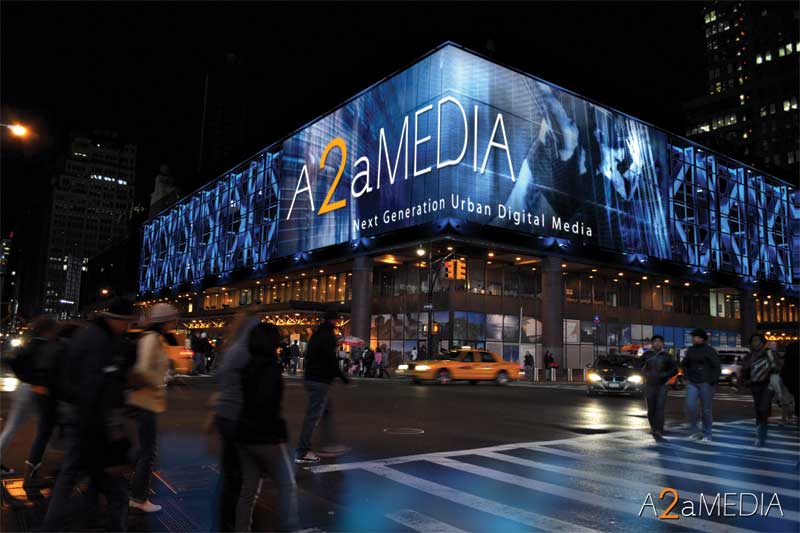
With a ‘media mesh’ installation, the LEDs are spaced apart, allowing people inside a building to see outside.
Photo courtesy Business Wire
Hardware selection
The hardware options for exterior digital signage vary significantly in terms of price and resolution.
Light-emitting diode (LED) screens are the industry standard for scrolling message signs and digital billboards, as they are ideal for displaying moving content from a distance. Many resolutions are available, though there are considerable cost differences from low to high.
Beyond billboards, one of the advantages of LED screens is they can be arranged in different shapes to suit a building’s architecture. There are even ‘media mesh’ options where the LEDs are spaced apart, allowing people inside the building to see outside.
Another emerging option is to arrange organic LEDs (OLEDs) into a transparent or translucent screen. OLEDs lend themselves well to intricate shapes and can handily turn an existing surface, such as a window, into a screen.
Liquid crystal displays (LCDs) dominate indoor digital signage deployments, but they have also become popular for outdoor applications, housed behind glass façades or within weather-resistant enclosures. These are more typically pedestrian-facing ‘streetscape’ deployments in big cities.
Digital projection can be cost-effective for both small- and large-scale applications. Although it is only useful at night, the technology is reportedly used in 25 per cent of all digital signage applications.
Ongoing management and maintenance
All digital signs require extensive and ongoing attention to maintain their effectiveness, but the need is clearest with high-profile outdoor screens. When a digital sign is ‘broken,’ it has a significant negative impact on its owner’s brand identity.

LCDs are also often used outdoors, but within weather-resistant housings.
Photo courtesy Nanov Display
The ability to remotely monitor and update screen content is crucial. Larger operators can co-ordinate multiple digital billboards asa platform for national ad campaigns.
The ability to manage illumination levels remotely is also useful. Changing a screen’s brightness for day and night will both extend the life of the hardware and improve acceptance by the community. In some cases, this feature is required for bylaw compliance.
“There is a significant difference of as much as 70 to 90 per cent between luminescence needs during the day or night and, for that matter, between sunny and cloudy days,” says Philip M. Garvey, senior research associate for the Larson Institute at Pennsylvania State University, which has studied digital signage in depth.
Content legibility
As much as people’s attention is naturally attracted to the dynamic nature of digital signage, it is a double-edged sword, because changing content can be more difficult to read than a printed graphic. One of the biggest challenges in the industry has been to develop high-quality, consistently legible messaging.





